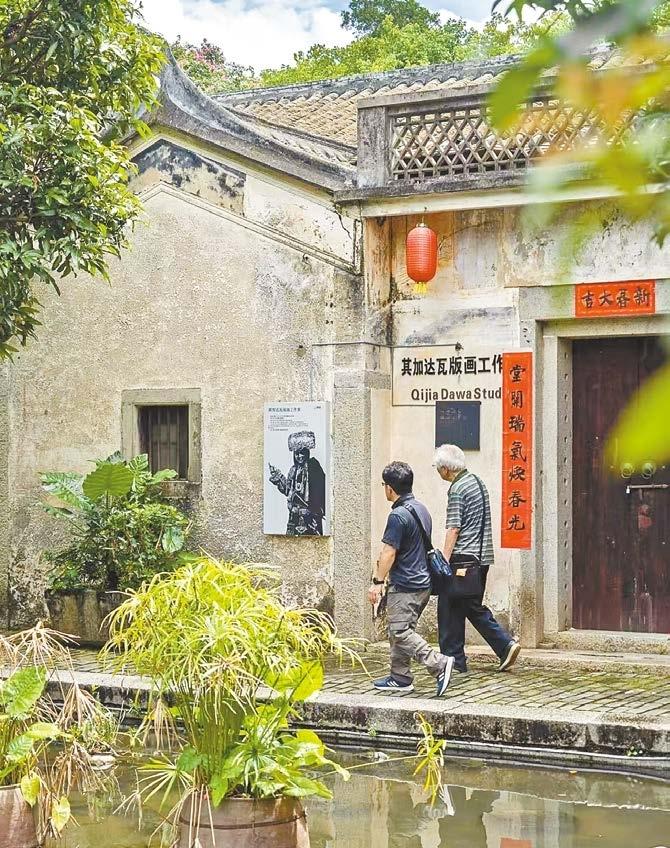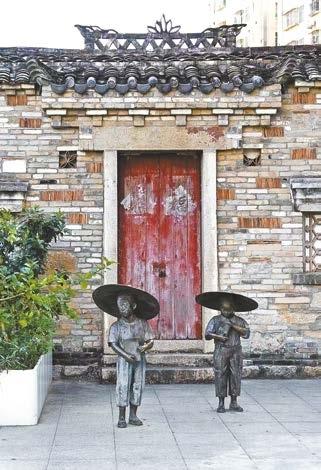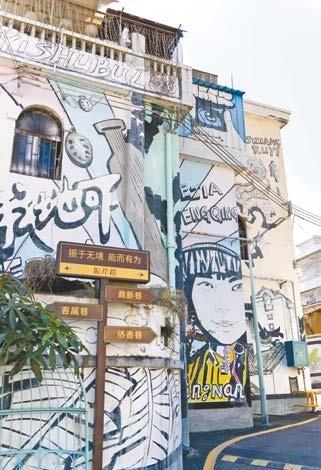


SHENZHEN is home to many ancient villages that are little known to the public. These century-old villages are away from the hustle and bustle of the city center, quietly nestled in a corner, providing spiritual nourishment to the city with their rich cultural heritage. In Longhua District, there is an abundance of ancient villages, which are scattered widely in subdistricts such as Guanlan, Dalang, Guanhu, and Fucheng. Join us as we explore the secrets of some of these ancient villages. New Who Art Village Just 500 meters away from Edixia Village lies another century-old village, New Who Art Village. Compared to Edixia Village, New Who Art Village is larger and more populated. It has its own art gallery, named New Who Art Museum, which frequently hosts exhibitions showcasing the works of local artists. The residents of New Who Village are mostly artists who have set up their studios here. Walking through any alley, you can see signs made of various materials and in different artistic styles hanging at the entrances of old houses. Visitors can simply follow the artists’ perspectives to capture the most beautiful scenes. With an art gallery and a theme restaurant, the village has hosted, for several years, a number of sideline events of the China (Shenzhen) International Cultural Industries Fair (ICIF), and has organized the New Who Art Festival for years. Metro: Line 4 to Niuhu Station, Exit B; then walk to the village Edixia Village Edixia Village, located in Guanlan Subdistrict, has a history of nearly 300 years. The village is tranquil, like a paradise away from the world. It allows people to relax both physically and mentally. Walking through Edixia Village, you can see many traditional Hakka buildings, such as row houses, ancestral halls, and watchtowers, all of which have retained their relatively original appearance. Edixia Village has now been transformed into an art village, where graffiti can be seen everywhere in the alleys, adding a unique color to this ancient village. Many corners of the village are worth capturing with a camera. Edixia Village is also the hometown of revolutionary printmaker Chen Yanqiao (1911-1970), a pioneer in modern Chinese printmaking and outstanding art theorist and educator. The Chen Yanqiao Exhibition Hall in the village used to be Chen’s old residence that was built during the late Qing Dynasty (1644-1911). Metro: Line 4 to Niuhu Station, Exit C; then walk and navigate to “Yanqiao Store” Guanlan Printmaking Village One of the best-known Hakka villages in Shenzhen, Guanlan Printmaking Village is a cultural landmark in the city. Covering an area of 1.4 million square meters, the village was built upon the former Dashuitian Old Village. True to its name, the village is a base of the printmaking industry, with printmaking workshops of various sizes and art corners being housed in the eastern area, and an international artist compound in the western part. Upon entering the village, the first thing that comes into eyes is the printmaking workshop. This is a teaching collaboration base for many well-known art academies in China, and many internationally renowned artists come here to exchange ideas. Metro: Line 4 to Niuhu Station, Exit A; then take a tax or a bus Shangwei Art Village Shangwei Art Village is an old village with a history of 400 years known as the place in Shenzhen that most resembles Lijiang in Southwest China’s Yunnan Province. Surrounded by mountains on three sides and adjacent to water, the village serves as a getaway from the bustling urban commercial life. There are four watchtowers and more than 50 traditional Hakka houses in the village. Artists and designers started settling here in 2016, adorning the old houses and ancient walls with graffiti, making the village as picturesque as a movie scene. The village is also home to over 40 artists with their studios across the village’s corners. Metro: Line 10 to Bantian North Station, Exit B; then take a taxi Qinghu Ancient Village One of the earliest villages in Shenzhen, Qinghu Ancient Village is where generations of the Liaos, the original inhabitants, have lived. The village preserves many cultural relics such as the Liao Family Ancestral Hall, Sanjie Temple, and Yuanzhu Family School. Behind the ancient village, there is a park well worth visiting — the Qinghu Cultural Park. The park is adjacent to residential areas and the Qinghu community, covering an area of 65,000 square meters. It has a strong Lingnan cultural atmosphere and features various cultural sculptures and scenic walls. There is also a rose garden of nearly 1,600 square meters, which is best visited during the blooming season in March. Metro: Line 4 to Qinghu North Station; then take a taxi Langkou Village Langkou Village is a settlement where Hakka people reside. As early as 1866, missionaries began preaching in Langkou Village, making it a Hakka village where the majority of the villagers were Christian. The church at the entrance, known as Langkou Church, was established in 1866. This marked the beginning of a new era of cultural integration between Chinese and Western cultures in Langkou Village, and the church is also one of the oldest in Shenzhen. Next to Langkou Church is the Qianzhen Girls’ School, which is another landmark building in the village. Metro: Line 4 to Longhua Station; then take a taxi or a bus (Wang Jingli) | 
